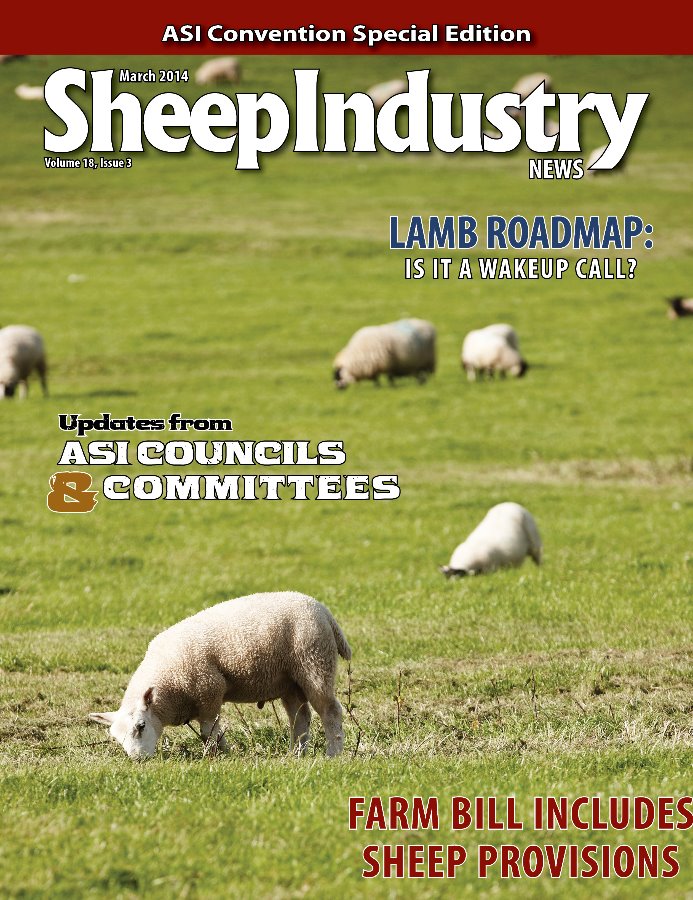
- March 2015
- President’s Notes
- Nearly 600 Participated in ASI Convention to Mark 150th Anniversary
- Smith: Animal Ag Needs to Protect Itself
- ASI Awards: Dedication to Sheep Industry
- Avalos Urges ASI to Support Livestock Reporting
- Wool Council Updated on Programs
- Wool Excellence: Mehta, Kott Honored for Service to Industry
- Market Report
- H-2A ‘Special Procedures’ Vital to Industry
- Breed Research Reported to PERC
- Legislative Council Shifts Spring D.C. Trip
- Let’s Grow Committee Begins to Build
- Pfliger Takes Reins as ASI President
- Buchholz, Ebert Elected to ASI Executive Board
- Stakeholder Committee Formed to Draft Sheep Station Defense
- Animal Health Updated on Bighorns, Scrapie
- Emerging Entrepreneurs Gain Momentum
- Sheep News Briefs
- Classified Ads
Animal Health Updated on Bighorns, Scrapie
As consumers are increasingly interested not only in the quality of their food but the care and handling of the animals that provide it, sheep producer participation in the Sheep Safety and Quality Assurance becomes ever more important.
“Increased consumer confidence is the main purpose of this program,” Melissa VanLaningham told the ASI Animal Health Committee in Reno. “Not only confidence in what’s on their plates, but how we produce it – the treatment of our animals and the treatment of the environment.”
VanLaningham is a veterinarian and director of Food Science for Superior Farms, where she oversees Superior’s Technical Services and Quality Assurance departments.
The Sheep Safety and Quality Assurance program, begun in the early 1990s in a collaboration between ASI and Colorado State University, is designed to generate safe, high quality sheep products by improving management practices during production.
In the battle to eradicate scrapie, Diane Sutton, a senior staff veterinarian with USDA/Aphis Veterinary Services, reported that on-farm surveillance is steadily increasing as a complement to slaughter surveillance.
She said that sheep and goat scrapie appear to be the same, adding that the industry needs to eradicate scrapie in both species before the United States is declared scrapie-free.
On another issue, Sutton discussed the halting of the import of ovine and caprine semen from European Union countries in 2011 to guard against the introduction of Schmallenberg virus, or SBV, which can cause congenital malformations and stillbirths in sheep, goats and cattle. Named for where it was first detected (Schmallenberg, Germany), SBV has been detected in nearly all countries of the European Union.
“We need to make sure that SBV doesn’t get into the United States,” said Sutton, adding that any semen brought in requires an import certificate.
Another disease of concern to sheep and goat producers is Coxiella burnetti, or Q fever. An outbreak in the Netherlands in 2007-2009 was followed by one in the U.S. Pacific Northwest two years later.
“Q fever represents a silent infectious disease with a seemingly different impact because it can affect humans,” said Don Knowles, research leader of the ARS Animal Disease Research unit in Pullman, Wash. The question is whether “rare research dollars” should be invested to address this problem.
A critical disease for the sheep industry is bighorn sheep pneumonia, especially because of the costly challenge of keeping the U.S. Forest Service from closing sheep allotments in mountain states near bighorn populations. “This is still a poorly understood disease phenomenon, but it is having a big economic impact,” said Maggie Highland, a veterinary researcher with the Animal Disease Research Unit at Pullman. Highland said reports of pneumonia outbreaks among bighorn sheep date from the 1920s, and “the cause has long been debated and continues to be debated.” What is known, she said, is that there is more than one bacterium involved in the disease, and the presence of bacteria does not necessary mean death: Animals can carry it without the bacteria causing the disease.
“Do domestic sheep carry the bacteria? Yes,” said Highland. “Are domestic sheep the only source? No, because bighorn sheep carry it as well.” She advised the sheep industry to judge critically any research on disease transmission between domestic and bighorn sheep. Highland’s current research is exploring whether domestic and bighorn sheep, raised equally, have equally protected immune systems.
Additional research is investigating other potential wildlife reservoirs or carriers of the disease and whether they are transmitting it to other animals. Under study are wild cottontail rabbits, deer and other wild ungulates.
On another front, Highland is initiating research on mycoplasm ovis. The work was triggered by a student worker observing a lamb with uncoordinated behavior. It was thought that the lamb had dislocated knees, but further inspection showed signs of neurological compromise.
Highland said the disease, distributed worldwide, is of concern to the sheep industry, even though reports of it and research on it are rare in the United States.
Mycoplasm ovis is typically transmitted by biting insects or needle reuse, and it can cause poor growth and death. Clinical symptoms, similar to those from enteric parasites, are anemia, jaundice, weight loss, ill thrift, stunting, diarrhea and neurological signs.
Research at Pullman is looking at distribution and prevalence in the United States along with seasonal infection prevalence.

